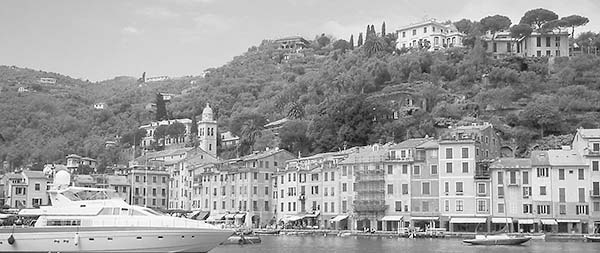
Levanto • Sestri Levante • Santa Margherita Ligure • Portofino • Porto Venere • La Spezia
Orientation to Santa Margherita Ligure
Sights in Santa Margherita Ligure
Sleeping in Santa Margherita Ligure
Eating in Santa Margherita Ligure
Santa Margherita Ligure Connections
The Cinque Terre is tops, but there’s much more to the Italian Riviera. To the north of the Cinque Terre is a trio of beach towns: Levanto, the northern gateway to the Cinque Terre; Sestri Levante, stunningly situated on a narrow peninsula flanked by two beaches; and Santa Margherita Ligure, a thriving city with an active waterfront and easy connections to yacht-happy Portofino. At the south end of the Cinque Terre is the pretty resort of Porto Venere and the region’s gritty transit hub, La Spezia.
The best of these towns—the high-end yin to the Cinque Terre’s ramshackle yang—can be user-friendly home bases for day trips along the Riviera coast. But they are also worth visiting in their own right. After exploring the villages and trails of the Cinque Terre, these Riviera towns feel like a return to civilization.
Riviera hotels aren’t necessarily cheaper than the Cinque Terre, but they are more likely to have space. High season here is roughly May through September, peaking in July and August. Some hotels close in winter.
Home Bases: Levanto, Sestri Levante, and Santa Margherita Ligure are practical home bases for drivers wanting to park at their hotel and side-trip to the Cinque Terre by train, or for those who want modern hotels with predictable resort amenities. (They’re also worth a look if you find the Cinque Terre booked up.)
Levanto—just minutes north of Monterosso by train—is the handiest. Sestri Levante is a bit farther away with a little less train service. Santa Margherita Ligure is the most distant and often requires a transfer to the Cinque Terre, but the town compensates by being the most appealing—and it gives you easy access to posh Portofino. Porto Venere is better as a day trip, and La Spezia is more functional than appealing, although either can serve in a pinch.
If you home-base near the Cinque Terre, keep in mind that you’ll be competing with other day-trippers for space on prime midday trains to and from the Cinque Terre. Turn this problem into an advantage: Enjoy your home-base town during the day, then head into the Cinque Terre in the late afternoon for untrampled charm, a romantic dinner, and a late train back.
When most people imagine the “Italian Riviera,” they’re thinking of the shimmering resort towns north of the Cinque Terre. Stately Old World hotels loom over crowded pebble beaches with rentable umbrellas. Fastidiously landscaped parks and promenades are jammed with more Italian visitors than American tourists. These towns are perfect for day-tripping—or even an overnight.
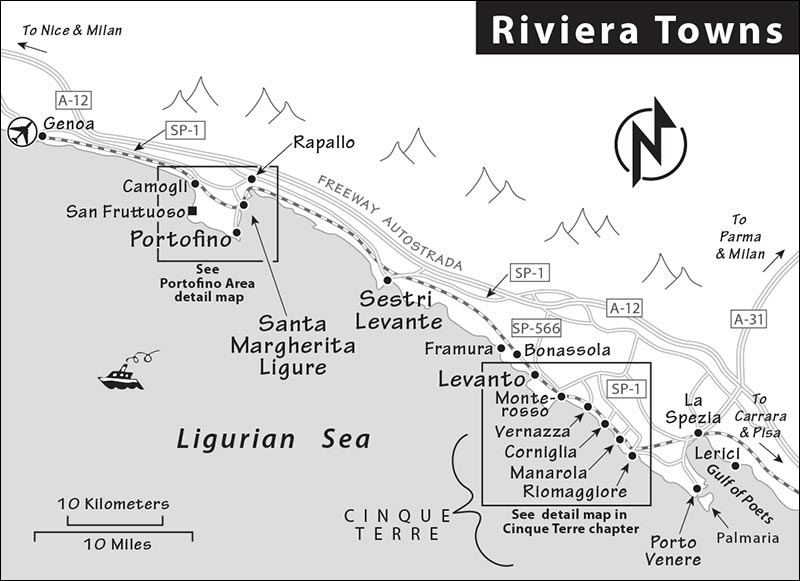
Graced with a long, sandy beach, Levanto (LEH-vahn-toh) is packed in summer and popular with families and surfers. The rest of the year, it’s just a small, sleepy town with kids playing in the square and locals whizzing around on bicycles. Although not as charming as the Cinque Terre, it enjoys fewer crowds, more varied hotel and dining options, and quick connections to the Cinque Terre (4 minutes to Monterosso by train, continuing to the rest of the Cinque Terre villages on the same line).
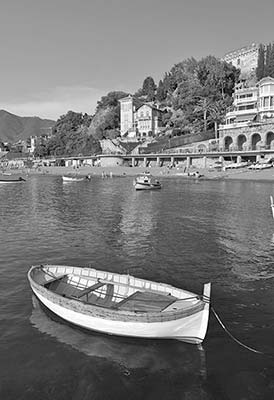
This beach town isn’t the “real” Cinque Terre, but it can be a friendly home base for budget travelers, beach bums, or families with kids who like to bike or play on the beach. (It has a high number of family rooms and large, affordable apartments with kitchenettes.) From Levanto, you can hop a train or boat to the Cinque Terre towns and beyond; take the no-wimps-allowed hike to Monterosso (3.5 hours); or bike or stroll on a delightful, level path to the nearby, uncrowded beach village of Bonassola, and farther on, smaller Framura.
Levanto (pop. 5,400) is dominated by an uninspiring new town, a regular grid street plan of five-story apartment buildings that stretches from the train station down to the broad, curving beach. The sleepy, twisty old town—bisected by a modern street—is tucked up against the adjacent hill.
Tourist Information: A Cinque Terre National Park info center is at the train station. The helpful TI is on Piazza Cavour (daily 9:00-13:00 & 15:00-18:00 except closed Sun afternoon, shorter hours off-season, tel. 0187-808-125, www.visitlevanto.it).
By Train: From the train station (no baggage storage), head through the parking lot and down the stairs, turn right, and cross the bridge onto Corso Roma—the main drag. The beach is straight ahead, and most of my recommended hotels, restaurants, and the TI are in the grid of streets to your left. You can walk from the station to most of my recommended places in about 10 minutes.
By Car: If your hotel doesn’t offer parking—or if you’re not sleeping here—you have a couple of good alternatives. The lots surrounding the train station are affordable and handy for hopping a train to the Cinque Terre towns. If you’re heading for the beach, the parking lot there is handy but more expensive.
Markets: Levanto’s modern covered mercato, which sells produce and fish, is on Via XXV Aprile, between the train station and the beach (daily 7:30-13:00). On Wednesday morning, an open-air market with clothes, shoes, and housewares fills the street in front of the mercato.
Laundry: A self-service launderette stuffed with snack-and-drink vending machines is at Piazza Staglieno 38, facing an inviting park (daily 24 hours, mobile 338-701-6341). Another self-service place, Speedy Wash, is at Via Garibaldi 32 (daily 8:00-22:00, mobile 338-701-6341).
Bike Rental: Relatively flat Levanto, with light traffic, is a great bike town—and the ride to nearby Bonassola and Framura is easy and delightful. Try Cicli Raso (€10-20/day depending on bike, daily 9:30-12:30 & 15:30-19:00, closed Sun Nov-April, Via Garibaldi 63, tel. 0187-802-511) or the Sensafreni Bike Shop, convenient to the beach boardwalk, with well-maintained bikes (€5/hour, €8/half-day, €15/day, more for ebikes, daily 9:00-13:00 & 16:00-19:30, Piazza del Popolo 1, tel. 0187-807-128).
Sports Rentals: Right on the beach, Rosa dei Venti rents kayaks, canoes, surfboards, and windsurfing equipment (mobile 329-451-1981, www.levantorosadeiventi.it, Marco).
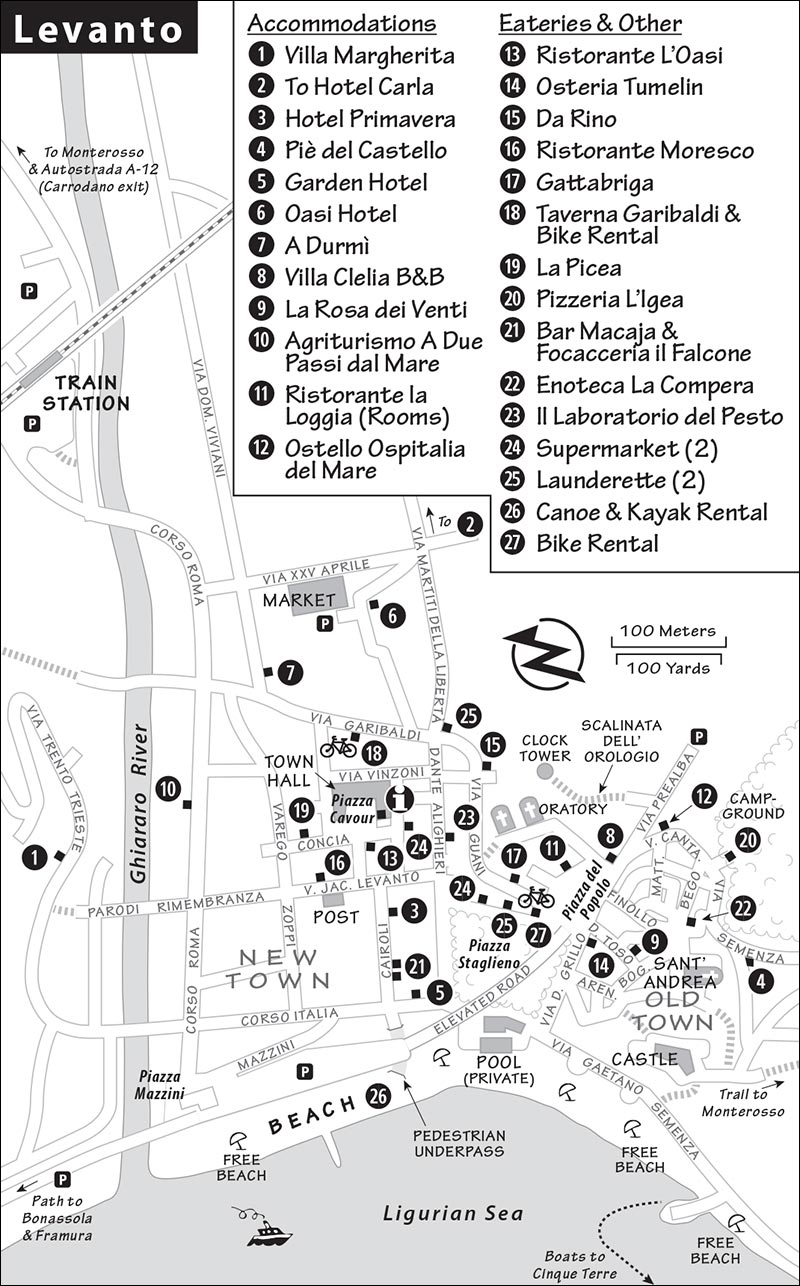
Electric Bike Tours: Ebikein offers a variety of guided tours on electric bikes—giving you a helpful boost on the hills. Options include a four-hour loop around the Bay of Levanto (€58) and a four-hour pedal up to some of the sanctuaries above the Cinque Terre towns (€69, www.ebikein.com, mobile 334-190-0496).
Boat Tours: Sea Breeze operates out of Monterosso but will pick you up in Levanto for full-day or aperitivo sunset tours. See their listing on here.
Levanto’s beach hides below a parking lot and promenade that’s elevated above the sand—look for underpasses or stairs along its length. There are pretty boardwalks up on the elevated promenade and down along the beachfront. As you face the harbor, the boat dock is to your far left, and the diving center is to your far right.
In summer, three parts of the beach are free: both sides of the boat dock, and near Piazza Mazzini. The rest of the beach is broken up into private sections that you pay to enter. Pay beaches come with comfy lounge chairs, bar service, showers, and someone keeping an eye on your things while you swim. Shop around to find the best price (€15-20/chair, less in the afternoon). You can always stroll along the beach, even through the private sections—just don’t sit down. Off-season, roughly October through May, the entire beach is free, and you can lay your towel anywhere you like. Ask your hotel for towels; most have beach towels to loan or rent.
The city’s seaside pool is privately run and is for serious lap swimmers only. Check with your hotel; they may have entry passes.
The old town clusters around Piazza del Popolo. Until a few decades ago, the town’s open-air market was held at the 13th-century loggia (covered set of archways) in the square.
Explore the back streets. The original medieval town spreads from Via Guani to the oratory of San Giacomo and the old clock tower, and from the loggia to the Church of Sant’Andrea (c. 1212). Levanto was once an important harbor of the Republic of Genoa (the second biggest harbor after Genoa itself); from here, shipments of olive oil, wine, and the coveted red marble called rosso levanto set sail. You can still discover traces of ancient warehouses and the dockland area around Piazza del Popolo.
This 3.5-hour hike from Levanto to Monterosso is strenuous at the beginning and end but easier in the middle (for details, see here). To begin in Levanto, start on Piazza del Popolo, and head uphill to the striped Church of Sant’Andrea. From the church courtyard, follow the sign to the castello (a private residence), go under the stone arch, and continue uphill. From here, take trail SVA (following signs toward Punta Mesco, the rugged tip of the peninsula), then drop steeply down into Monterosso. (If you have knee issues, consider starting in Monterosso instead.)
Tucked just off the main train line on a cove north of Levanto, the small beach resort of Bonassola (boh-nah-SOH-lah, pop. 950) is a peaceful little eddy. As far as Riviera beach resorts go, this is a jewel. With a low-key vibe, a tidy grid street plan that feels almost French, and a picturesque dark-sand beach hemmed in by jagged bluffs, Bonassola is a fine alternative to the region’s other beaches. And the next best thing to a beach day in Bonassola is getting there: A level, easy, rails-to-trails path cuts through the mountain from Levanto—enjoyable by foot, but even better by bike.
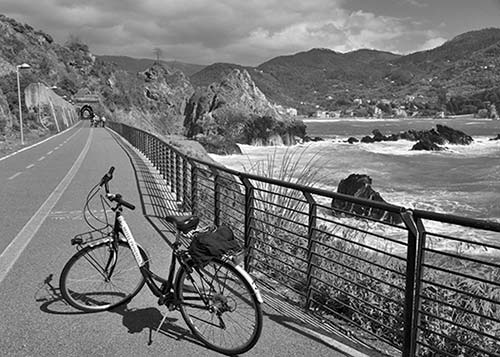
Levanto to Bonassola: Local trains run between Levanto and Bonassola (hourly, 3 minutes, confirm your train will stop in Bonassola). But I’d rather take the promenade. At the northern end of Levanto’s beachfront road/parking lot, you’ll find a level, roughly 1.5-mile path neatly divided into bike and pedestrian lanes. Most of the route is through well-lit former train tunnels, with brief breaks overlooking the sea (and hikes down to secluded beaches). The walk takes about 30 minutes, with long stretches through cool tunnels; by bike, it’s less than 10 minutes.
Visiting Bonassola: The town itself—with manicured promenades and piazzas—is worth exploring. $$ Caffè delle Rose, facing the town’s elevated road (at Via Fratelli Rezzano 22), has good gelato, food, and drinks. Several foccacerie and other eateries cluster at the far end of town.
The beach is separated from the town center by the elevated road (shared by bicyclists, walkers, and a parking lot). The inviting beach has mostly private sections, with a few free public areas.
For a scenic walk/hike, head to the far (north) end of the beach, where a promenade snakes along the base of the cliff (with rocky perches for sunbathing and swimming). For higher views, find the stairs near the flagpole, and follow the steps up on the right side of the yellow church. Popping out at the top, turn left along the scenic, private road as it curls around the top of the bay, with great views back on the town and beach; the path ends at the blocky little Madonnina della Punta chapel.
Bonassola to Framura (best for bicyclists): From Bonassola, the promenade continues another 1.5 miles to the town of Framura—a settlement made up of five medieval hamlets that rise up from the seafront to the hilltop (pop. 750). Because this part of the route is almost entirely through tunnels, it’s boring for walkers—but quick for bikers. The trail ends overlooking Framura’s rocky little harbor and near its train station (there’s no direct access to the station—don’t count on taking your bike back on the train).
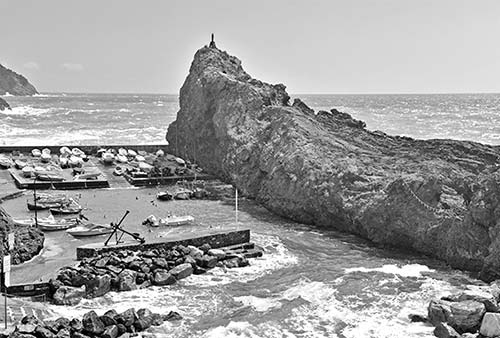
Visiting Framura: Park your bike at the trailhead and hike down to the harbor, cross under the train tracks, and emerge near the station and the start of the scenic Via del Mare path (basic café at trailhead). This easy promenade takes you north along a cliff face in 10 minutes to two small, pristine gravel beaches that are free and uncrowded.
Hikers can walk the panoramic but steep trail that connects the five hamlets, which are sprinkled with medieval watchtowers, churches, and washhouses. To avoid the uphill climb, ride the summer shuttle to any of the five towns and walk down (shuttles run hourly, timed to the arrival of trains from the Cinque Terre). The welcoming TI at the Framura station has maps and advice (mobile 339-543-3923, www.framuraturismo.it).
$$$ Villa Margherita, in a 1906 Art Nouveau building, is across the river and a bit uphill (about a 10-minute walk from the town center or train station), but the shaded view gardens, 11 characteristic colorfully tiled rooms, and tranquility are worth the walk (family rooms, deluxe apartment, air-con, elevator one flight up from street level, free parking, Via Trento e Trieste 31, tel. 0187-807-212, mobile 328-842-6934, www.villamargherita.net, info@villamargherita.net, Paola).
$$$ Hotel Carla sits in a humdrum residential zone, about 10 minutes from the beach and the station. Its 30 rooms come with surprising contemporary style—most have balconies, and all are decorated in soothing, neutral colors (RS%, family rooms, air-con, elevator, free loaner bikes, Via Martiri della Libertà 28, tel. 0187-808-275, www.carlahotel.com, info@carlahotel.com).
$$$ Hotel Primavera is homey and family-run, with 17 colorful rooms—10 with balconies (but no views)—just a block from the beach (family rooms, request a quiet room off the street, includes hearty breakfast buffet, air-con, pay private parking, free loaner bikes, Via Cairoli 5, tel. 0187-808-023, www.primaverahotel.com, info@primaverahotel.com; friendly Carlo, cheerful Daniela, and daughters Giuditta and Gloria).
$$$ Piè del Castello is just above the campground, right on the Levanto-Monterosso trail. Andrea and his wife rent three double rooms, each with a patio and access to a sprawling garden with views of the ancient city wall and the Church of Sant’Andrea. Hikers will appreciate the location and Andrea’s knowledge of area trails (air-con, fridge, ping-pong table, free parking, Via Guido Semenza 2, tel. 366-1467-7886, www.piedelcastello.com, info@piedelcastello.com).
$$$ Garden Hotel offers 17 functional, businesslike, modern rooms (all with balconies but no views) on the first floor of an apartment building. While it’s a lesser value, you’re paying for proximity to the beach—it’s just across the street (a more expensive fifth-floor room has sea views and a terrace, closed Nov-mid-March, air-con, elevator, free parking but not on-site, loaner bikes, Corso Italia 6, tel. 0187-808-173, www.nuovogarden.com, info@nuovogarden.com, Davide and Damiano).
$$ Oasi Hotel, well-run by Silvia, has 14 rooms in a cozy small hotel behind the market hall. Some rooms have balconies, others have direct access to the garden, and a few have neither but are larger—request your choice when you reserve (RS%, air-con, elevator, parking extra, Via Ferraro, tel. 0187-807-356, www.oasihotel.eu, info@oasihotel.eu, Saverio).
$$ A Durmì is a happy little guesthouse owned by lovely Graziella, Gianni, and their two daughters, Elisa and Chiara. Their sunny patios, green leafy gardens, six immaculate beach bungalow-type rooms, and five sunlit apartments make this a welcoming place to stay (breakfast extra, family rooms, air-con, bar, pay parking, Via D. Viviani 12, tel. 0187-800-823, mobile 349-105-6016, www.adurmi.it [URL inactive], info@adurmi.it).
$$ Villa Clelia B&B offers five basic rooms (named for the winds—scirocco, maestrale, and so on) with minifridges and terraces. The rooms surround a garden courtyard just a short walk up from the sea (minimal in-room breakfast, air-con, free parking; with the old town’s loggia on your left, it’s straight ahead at Piazza da Passano 1; tel. 0187-808-195, mobile 329-379-4859, www.villaclelia.it, info@villaclelia.it). They also rent apartments in the center that economically sleep up to five.
$$ La Rosa dei Venti is an affittacamere just a couple of blocks from the beach, in the old town. Enthusiastic Rosanna and her son Marco rent five old-fashioned, overpriced rooms with dark hardwood floors, comfy rugs, and glittery seashore decor (air-con, pay parking, from Piazza del Popolo take the lane next to Osteria Tumelin to Via della Compera, tel. 0187-808-165, Marco’s mobile 328-742-8268, www.larosadeiventilevanto.com, info@larosadeiventilevanto.com).
$ Agriturismo A Due Passi dal Mare is an in-town oasis, just a five-minute walk from the beach or the train station. Friendly Francesca and husband Maurizio rent four crisp, quiet rooms—with sizable bathrooms—in the 1920s home built by her grandfather; their back garden is open to guests (free on-site parking, closed Jan-Feb, right on the main drag at Corso Roma 37, tel. 0187-809-177, mobile 338-960-1537, www.a2passidalmare.com, info@a2passidalmare.com).
$ Ristorante la Loggia has eight cozy, older, and cheap rooms, perched above the old loggia on Piazza del Popolo (request balcony, quieter rooms in back, two basic side-by-side apartments great for families of 4-8, lots of stairs, air-con, free parking, reception open 9:00-23:00, Piazza del Popolo 7, tel. 0187-808-107, mobile 335-641-7701, www.loggialevanto.com, laloggialaloggia@gmail.com, Alessandro). They also have a recommended restaurant.
Hostel: ¢ Ostello Ospitalia del Mare, a budget gem, is run by the city tourist association. It has 70 basic beds, airy rooms, an elevator, and a terrace in a well-renovated medieval palazzo a few steps from the old town (all ages, dorms with private bath, private rooms, includes breakfast, self-service laundry, no curfew or lockout; office open daily April-Oct 8:00-12:30 & 16:00-19:30, until 23:00 weekend nights; may close Nov-March, Via San Nicolò 1, tel. 0187-802-562, www.ospitalialevanto.com, info@ospitalialevanto.com).
$$$$ Ristorante L’Oasi—spacious, bright, and with a garden feel—is the place for quality fish and seafood in Levanto. Family run, with Claudio in the kitchen and Lella supervising the dining room, this is a polished setting for enjoying fresh tuna tartare, marinated anchovies, and grilled swordfish. If you really want to treat yourself, order a whole fish baked under salt (daily 12:30-14:30 & 19:00-22:30, closed Wed Sept-June, Piazza Cavour, tel. 0187-800-856).
$$$ Osteria Tumelin has a dressy ambience in its elegant dining room, a casual covered terrace out front, and a wide selection of fresh seafood. Reservations are smart on weekends or to dine outside. Check out the aquarium containing giant lobster and moray eels in the first dining room on the right (daily 12:00-14:30 & 19:00-22:30, closed Thu Oct-May, Via D. Grillo 32, across the square from the loggia, tel. 0187-808-379, www.tumelin.it).
$$ Da Rino, a small trattoria on a quiet pedestrian lane, dishes up reasonably priced seafood, meat, and homemade Ligurian specialties. Consider the grilled totani (squid), pansotti con salsa di noci (ravioli with walnut sauce), and trofie al pesto (pasta with pesto sauce). Dine indoors or at one of the outdoor tables (Wed-Mon 19:00-22:00, closed Tue, Via Garibaldi 10, tel. 0187-813-475).
$$ Ristorante la Loggia, a Levanto standby, has been dishing up classic Ligurian cuisine for more than 50 years. Choose between the homey, wood-paneled dining room with nooks and crannies or the little terrace overlooking the square (daily 12:30-14:00 & 19:00-22:00, closed Nov-Feb, Piazza del Popolo 7, tel. 0187-808-107). They also rent rooms (see previous page).
$$$ Ristorante Moresco serves large portions of pasta and seafood at reasonable prices in a vaulted, candlelit room decorated with Moorish-style frescoes (daily 12:00-14:00 & 19:00-21:00, reservations appreciated, Via Jacopo 24, tel. 0187-807-253, busy Roberto and Francesca).
$$ Gattabriga hides out on a back lane behind Piazza del Popolo with a contemporary look; an updated and well-priced menu of pastas, seafood, and meats; and friendly service (Tue-Sun 19:00-21:30, closed Mon, Via Guani 47, tel. 366-527-3582).
$$ Taverna Garibaldi, a comfy good-value place on the town’s most characteristic street, serves focaccia with various toppings, made-to-order farinata (savory chickpea crêpe), salads, and more than 30 types of pizza (Fri-Wed 19:00-22:00, closed Thu, Via Garibaldi 57, tel. 0187-808-098).
$$ La Picea offers wood-fired pizzas and a large selection of beers to-go, or you can dine at one of their few small tables (Tue-Sun 12:00-14:00 & 19:00-24:00 or until they use up their pizza dough, closed Mon, just off Piazza Cavour at Via della Concia 18, tel. 0187-802-063).
$$ Pizzeria L’Igea, usually packed with locals, is tucked just inside the Campeggio Acquadolce campground, 50 yards past the hostel. It’s a favorite among locals who know you don’t have to be a camper to enjoy freshly made, budget-conscious pizza and pasta in their bright dining hall. Their specialty is gattafin—deep-fried herb-stuffed ravioli. Come early or be prepared to wait, even for takeout (daily 12:00-14:30 & 18:45-22:30, Via Guido Semenza 5, tel. 0187-807-293).
$-$$ Bar Macaja, decorated in shabby chic beach-style, is a tiny place with a big happy vibe. Stop in for a continental breakfast, espresso or a drink, panini, and local seafood—including anchovies prepared six ways (Fri-Wed 7:00-23:00, closed Thu, just up from the beach at Via Cairoli 25, mobile 349-844-8424).
$ Enoteca La Compera offers a quiet respite on a hidden courtyard across the way from the campground. It’s casual and friendly, serving a wide variety of panini that you can buy to-go, as well as plenty of wine, including affordable tastings, called degustazione (Tue-Sun 10:00-20:00, closed Mon, follow the red-brick road—under the stone arch—to Piazza della Compera 3, mobile 334-712-8517).
Picnics and Bites on the Go: Focaccerie, rosticcerie, and delis with takeout pasta abound on Via Dante Alighieri. $ Focacceria il Falcone has a great selection of focaccia with different toppings (daily 9:30-22:00, shorter hours off-season, Via Cairoli 19, tel. 0187-807-370). For more picnic options, try the mercato (see “Helpful Hints,” earlier). It’s fun to grab a crusty loaf of bread, then pair it with a pot of freshly made Genovese pesto and other gifty edibles from $ Il Laboratorio del Pesto (daily, Via Dante 14).
There are two Crai supermarkets (daily 8:00-20:00 except closed for lunch on Sun): One is just off Piazza Cavour at Via del Municipio 5; the other is nearby on Piazza Staglieno. For a shaded setting, lay out your spread on a bench in the grassy park at this piazza. Another fine picnic spot is Piazza Cristoforo Colombo, located east of the swimming pool, with benches and sea views.
To get to the Cinque Terre from Levanto, you can take the train (3-4/hour, 4 minutes to Monterosso). A slower, more scenic option is the boat, which stops at every Cinque Terre town (except Corniglia) before heading to Porto Venere (3/day in high season, price depends on distance traveled—or get a €35 all-day hop-on, hop-off ticket; only one return boat daily from Porto Venere—departs at about 16:30; get latest boat schedule and price sheet at TI or boat dock or check website, tel. 0187-732-987, www.navigazionegolfodeipoeti.it).
Sestri Levante (SEH-stree leh-VAHN-teh) is squeezed as skinny as a hot dog between its two beaches. The pedestrian-friendly Via XXV Aprile, which runs down the middle of the peninsula, is lined with shops that sell takeout pizza, pastries, and beach paraphernalia.
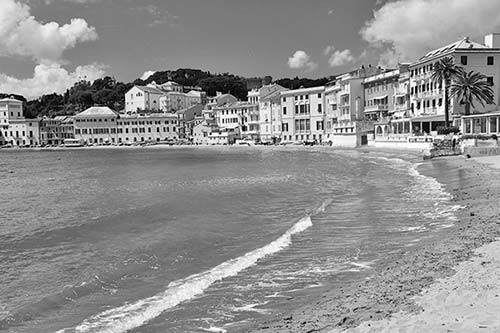
Hans Christian Andersen enjoyed his visit here in the mid-1800s, writing, “What a fabulous evening I spent in Sestri Levante!” One of the bays—Baia delle Favole—is named in his honor (favole means “fairy tale”). The small mermaid curled on the edge of the fountain behind the TI is another nod to the beloved Danish storyteller.
Sestri Levante (pop. 18,000) is dominated by its big, dull modern town in front of the train station. But don’t be discouraged—the old-town peninsula, a 10-minute walk away, has charm to spare.
Tourist Information: It’s at Corso Colombo 50, on the ground floor of Palazzo Fascie, the town’s cultural center (daily 9:00-13:00 & 14:00-17:00, shorter hours off-season, tel. 0185-478-530, www.sestri-levante.net). They can tell you about the summer bike-sharing program (€8/5 hours) and direct you to the trail (south of town) for a 1.5-hour hike (each way) to the scenic Punta Manara promontory.
Arrival in Sestri Levante: From the train station (no baggage storage), head straight out and across the piazza to go down the arcaded Via Roma. (If you need picnic supplies, you’ll pass a Carrefour Express.) To reach the enjoyable pedestrian zone, the old-town peninsula, and beaches, follow the “Stroll the Town” advice below.
Market Day: It’s on Saturday at Piazza Aldo Moro (8:00-13:00).
Laundry: A self-service launderette is in the urban zone southeast of the train station (daily 8:30-20:30, Via Costantino Raffo 8, mobile 389-101-1454).
For a get-acquainted walk through town, head out from the train station and follow Via Roma until it dead ends at the leafy city park. Go left a few blocks to Corso Colombo (just past the Bermuda Bar). This main drag will take you to the TI before turning into the mostly pedestrianized Via XXV Aprile. This street, running the length of the peninsula, is lively with shops, eateries, and delightful pastel facades. When you reach Piazza Matteotti, dominated by a large white Renaissance-era church, you’re at the narrow waist of the isthmus, with beaches to the right (pay) and left (free). If you continue up the lane to the left of the church, you’ll pass a scenic amphitheater, then the evocative arches of a ruined chapel (bombed during World War II and left as a memorial). A few minutes farther on, past a stony Romanesque church, the road winds to the right to Grand Hotel dei Castelli. The rocky, forested bluff at the end of the town’s peninsula is actually the huge private backyard of this fancy hotel.
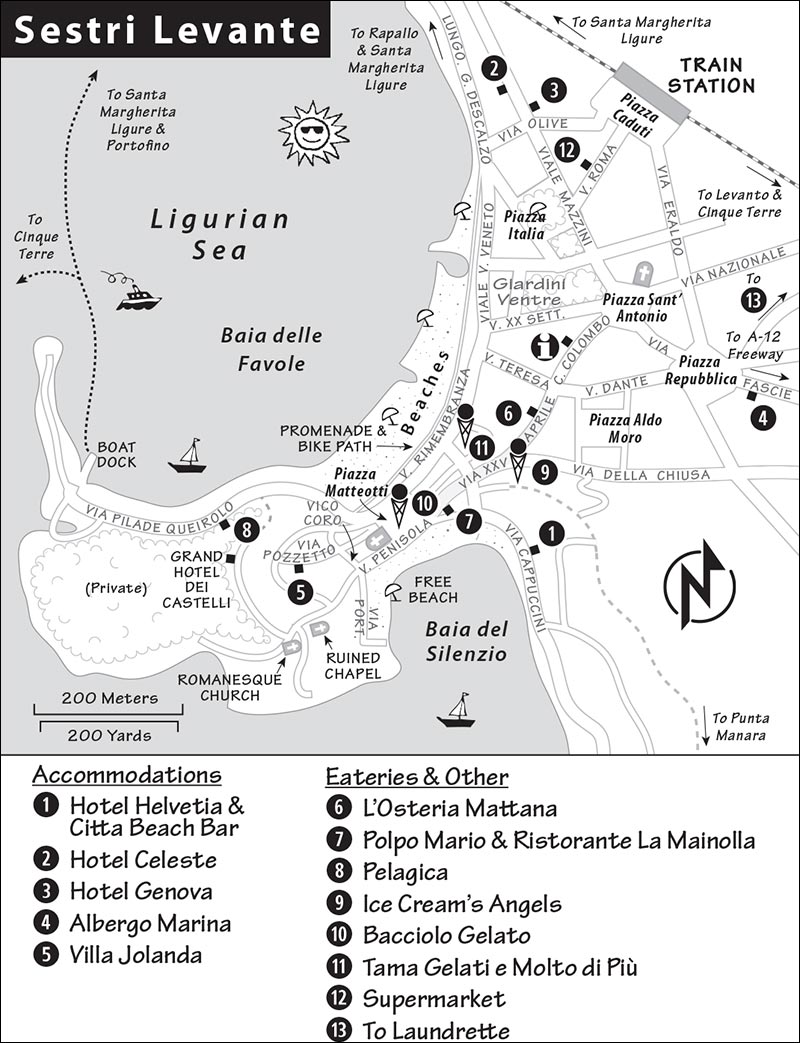
These are named after the bays (baie) that they border. The less scenic, bigger beach, Baia delle Favole, is divided up much of the year (May-Sept) into sections that you must pay to enter. Fees, up to €30 per day in August, generally include chairs, umbrellas, and fewer crowds. There are several small free sections: at the ends and in the middle (look for libere signs, and ask “Gratis?” to make sure that it’s free). For less expensive sections of beach (where you can rent a chair for about €8-10), ask for spiaggia libera attrezzata (spee-AH-jah LEE-behr-ah ah-treh-ZAHT-tah). The usual beach-town activities are clustered along this baia: boat rentals, sailing lessons, and bocce courts.
The town’s other beach, Baia del Silenzio, is picturesque, narrow, virtually all free, and jam-packed, providing a good chance to see Italian families at play. There isn’t much more to do here than unroll a beach towel and join in. Because of the bay’s small size and the currents, the water gets warmer here than at Baia delle Favole. At the far end of Baia del Silenzio (under recommended Hotel Helvetia) is the $$ Citto Beach bar, which offers front-row seats with bay views (summer until very late, spring and fall until sunset, sandwiches and salads at lunchtime only, Gilberto).
$$$$ Hotel Helvetia, overlooking Baia del Silenzio, feels posh and romantic, with 21 plush rooms, a large sun terrace with a heated, cliff-hanging swimming pool, and a peaceful garden atmosphere. With doubles renting for €400-plus in peak season, it’s a big but enticing splurge (family rooms, air-con, elevator, shuttle to off-site pay parking, closed Nov-March, Via Cappuccini 43, tel. 0185-41175, www.hotelhelvetia.it, helvetia@hotelhelvetia.it, Alex).
$$$ Hotel Celeste, a dream for beach lovers, rests along the waterfront. Its 41 rooms are modern, crisp, and pricey, but you’re paying for the sea breeze (family rooms, air-con, elevator, attached beachside bar/breakfast terrace, Lungomare Descalzo 14, tel. 0185-485-005, www.hotelceleste.com, info@hotelceleste.com, Franco).
$$ Hotel Genova, well-run by the Bertoni family, is a shipshape hotel with 19 shiny-clean, modern, and cheery rooms (three with sea view), a sunny lounge, rooftop sundeck, free loaner bikes, and a good location just two blocks from Baia delle Favole (ask for quieter room in back, family rooms, air-con, elevator, pay parking, Viale Mazzini 126, tel. 0185-41057, www.hotelgenovasestrilevante.com, info@hotelgenovasestrilevante.com, Stefano). They also book apartments in a nearby palazzo (www.appartamentisestrilevante.com).
$$ Albergo Marina’s friendly Magda and her brother Santo rent 23 peaceful, clean, good-value rooms painted in sea-foam green. Though the hotel is located on a busy boulevard in the more urban part of town, rooms face a quiet back courtyard and it’s a short walk to the beach (family rooms, air-con, elevator, free self-service laundry, pool table, closed Nov-Easter, Via Fascie 100, tel. 0185-41527, www.marinahotel.it, marinahotel@marinahotel.it).
$ Villa Jolanda is a homey, bare-bones pensione on the hilly old town streets beyond the pedestrian zone. It has 17 dated rooms (5 with little balconies and territorial views) and a garden courtyard/sun terrace—perfect for families on a budget (family rooms, pay parking, near Piazza Matteotti at Via Pozzetto 15—go up the lane to the right of the church, tel. 0185-41354, www.villajolanda.it, info@villajolanda.it, Mario).
You’ll find many eateries along the classic Via XXV Aprile, which also abounds with focaccerie, takeout pizza by the slice, and little grocery shops. Assemble a picnic or try one of the places below.
$$ L’Osteria Mattana has long, shared tables in two white-tiled dining rooms (one in front and the other past the wood oven and brazier). Daily specials—most featuring seafood—are listed on chalkboard menus (lunch Sat-Sun only 12:30-14:30, dinner daily 17:30-22:30, closed Mon Oct-April, cash only, Via XXV Aprile #34, tel. 0185-457-633, Marco).
$$$ Polpo Mario serves traditional seafood dishes and pastas from their fun people-watching location on the main drag (daily 12:00-15:00 & 19:00-23:30 except closed for lunch on Mon, Via XXV Aprile 163, tel. 0185-480-203).
$$$ Pelagica, a contemporary restaurant with a choice spot overlooking the Baia delle Favole, focuses on seafood—from anchovies to fried squid to traditional fish soup. Their rooftop terrace doubles as a cocktail lounge in the evening (daily 12:30-14:30 & 17:00-late, closed Wed in off-season, Via Pilade Queirolo 7, mobile 388-20255).
$$ Ristorante La Mainolla offers pizzas, big salads, focaccia sandwiches, and reasonably priced pastas near Piazza Matteotti (daily 12:00-16:00 & 19:00-22:00, Via XXV Aprile 187, tel. 0185-42792).
Gelato: Tourists flock to Ice Cream’s Angels, at the intersection of Via XXV Aprile and Via della Chiusa, where Riccardo and Elena artfully load up your cone and top it with a dollop of Nutella chocolate-hazelnut cream (open daily until late in summer). Bacciolo enjoys a similar popularity (closed Thu, Via XXV Aprile 51, on the right just before the church). Tama Gelati e Molto di Più makes their gelato daily with fresh ingredients (near the beach at Baia delle Favole, Viale Rimembranza 34).
By train, Sestri Levante is 30 minutes from Monterosso (hourly connections with Monterosso; nearly hourly with other Cinque Terre towns, requiring a change in Levanto or Monterosso) and 30 minutes from Santa Margherita Ligure (2/hour).
Boats depart to the Cinque Terre, Porto Venere, Santa Margherita Ligure, Portofino, and San Fruttuoso from the dock (molo) on the peninsula (Easter-Oct, tel. 0185-284-670, www.traghettiportofino.it).
If you need the Riviera of movie stars, park your yacht at Portofino. Or you can settle down with more elbow room in nearby and more personable Santa Margherita Ligure (SAHN-tah mar-geh-REE-tah lee-GOO-reh), one hour by train from the Cinque Terre. While Portofino’s velour allure is tarnished by a nonstop traffic jam in peak season, Santa Margherita Ligure tumbles easily downhill from its train station. The town has a fun Old World resort character and a breezy harborfront with a beach promenade. With its nice big-city vitality, it feels bustling and lived-in, even off-season.
On a quick day trip to Santa Margherita Ligure from the Cinque Terre or Milan, walk the beach promenade and see the old town center before catching the bus or boat to Portofino to discover what all the fuss is about. With more time, Santa Margherita Ligure (pop. 10,200) makes a fine overnight stop or a home base for visiting the Portofino peninsula or a foray into the Cinque Terre.
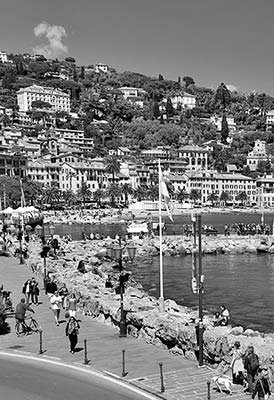
Tourist Information: The TI is as central as can be, in a green kiosk at the harborside of the city traffic hub, Piazza Vittorio Veneto (daily 9:30-13:00 & 16:30-19:00, shorter hours off-season, tel. 0185-205-456, www.smlturismo.it). The ATP bus office has a ticket desk there, and bus #82 to Portofino stops at the curb in front.
By Train: The station is a pleasant, low-stress scene. The bar/café (facing track 1) stores bags (small fee) and sells bus, train, and sightseeing-boat tickets.
To get from the station to the city center, take the stairs marked Mare (sea) down to the harbor; or turn right and head more gently down Via Roma, which leads to the town center, the TI, the start of my town walk, and recommended hotels (about 10 minutes away on foot). Bus #82 to Portofino stops a few steps below the station (4/hour, buy €3 one-way or €5 round-trip ticket at station bar/café, €1 more from driver).
By Car: Ask your hotelier about parking; some have free spots. Otherwise, try a private pay lot such as the Garage Europa autopark next to the post office (Via Roma 38). An hourly pay-and-display lot is by the harbor, in front of the fish market. Parking is generally free where there are white lines; blue lines mean you pay.
Market: A market sets up on Fridays on Corso Matteotti (8:00-13:00).
Laundry: Self-service Bolle Blu is near Piazza Mazzini (daily 7:00-22:30, Via Roccatagliata 39, mobile 335-642-7203).
Bike Rental: Ciclomania rents city and ebikes by the day and can put together guided day trips to nearby destinations (Mon-Sat 8:30-12:00 & 15:30-19:00, closed Sun, Via Luigi Bozzo 22, tel. 0185-283-530, www.ciclomania-liguria.it, Mimmo).
Scooter Rental: GM Rent rents scooters and Smart Cars (daily 10:00-13:00 & 16:30-20:00, Via XXV Aprile 11, tel. 0185-284-420, www.gmrent.it, Francesco).
Taxi: Taxis wait outside the train station and charge €15 for a ride anywhere in town, €25 to Paraggi beach, and €35 to Portofino (tel. 0185-286-508).
Driver: Helpful taxi driver Alessandro, who has both cars and minivans, offers airport transfers to Genoa, Milan, Florence, and Nice. He is also available for local excursions, including day trips to the Cinque Terre (mobile 338-860-2349, www.alessandrotaxi.com, alessandrotaxi@yahoo.it).
Get your bearings with this self-guided walk, starting on Piazza Caprera, the square facing the exuberant Baroque facade of the Basilica of Santa Margherita.
The town’s main church is textbook Italian Baroque (free, daily 7:30-12:00 & 15:00-18:30). Its 18th-century facade hides a 17th-century interior slathered with art and dripping with chandeliers. The altar is typical of 17th-century Ligurian altars—shaped like a boat, with lots of shelf space for candles, flowers, and relics. Its centerpiece is a much-venerated statue of Our Lady of the Rose that’s adorned this altar since 1756.
Baroque is theater...and this altar is stagecraft. After the Vatican II decrees of the 1960s, priests began to face their flocks instead of the old altars. For this reason, all over the Catholic world, modern tables serving as post-Vatican II altars stand in front of earlier altars, like the one here, that are no longer the center of attention during Mass.
Wander the church and its chapels, noticing the inlaid-marble floors and sparkling glass chandeliers. As you marvel at the richness, remember that the region’s aristocrats amassed wealth from trade from the 11th to the 15th century. When Constantinople fell to the Turks in 1453, free trade in the Mediterranean stopped, and Genovese traders became bankers—making even more money. A popular saying of the day was, “Silver is born in America, lives in Spain, and dies in Genoa.” Bankers here served Spain’s 17th-century royalty and aristocracy, and their accrued wealth paid for the art you see here.
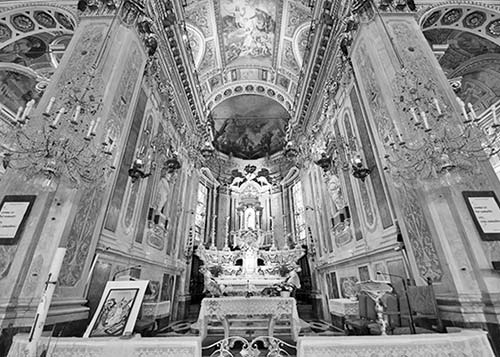
Each day this square hosts a few farmers selling their produce. On the corner of Via Cavour, just next to the basilica, visit Seghezzo, a venerable grocer where locals know they’ll find whatever they need.
• Now side-trip up the “via principale” (main drag) of the city, Via Palestro/Via Cavour. You’ll go two blocks up to Piazza Mazzini and back.
The main “street” here is really two parallel streets divided by very tall, narrow buildings. As you head up Via Cavour (on the left, by Seghezzo grocery) check out the shops on the right: The buildings that separate Via Cavour from Via Palestro are so skinny you see right through to the other side. The mix of fine boutiques, wine bars, jewelers, and casual restaurants hints at the elite—but not flashy—ambience of the town.
Study the building facades as you walk. It’s not unusual to see painted garlands gently hanging below a roofline or colorful ribbons over doorways and arches. Like a blank canvas, the houses are bedecked and embroidered in attractive styles. No two look just alike.
In two blocks, you’ll emerge onto a square, Piazza Mazzini, with enough elbow room to study the pastel house fronts. These facades were painted and decorated in the characteristic Ligurian trompe-l’oeil style from the turn of the last century. Every building presents some sort of illusion—the decorators went so far as to add painted-on upper windows, shutters, and window frames. Ligurians were practical: It was much less expensive to hire a painter than a sculptor to add decorative detail to these houses.
Now do a U-turn onto Via Palestro to return to where we started (staying straight past the recommended Angolo 48 restaurant on the corner). Walking here, notice that you’re surrounded by Italians doing the same passeggiata. At #34 (on the left), you’ll pass a traditional panificio (bakery) where you can say, “Vorrei un etto di focaccia” to treat yourself to about a quarter-pound of the region’s famed bread. Just beyond, on the right at #13, Fruttivendolo “Milanese” is just one of the many green-grocers in town selling an array of tempting produce and glass-jarred delicacies.

• Back on Piazza Caprera, turn left and walk away from the church one block to busy Largo Antonio Giusti. Next to the cinema (across the street), a penguin marks a recommended gelateria. Head right to Piazza Vittorio Veneto, with its busy roundabout and little park on the harbor. In the park facing the roundabout you’ll find the TI, ATP bus office, and a bus stop for Portofino. Use the crosswalks to negotiate the busy intersection and reach the promenade.
Take a look to the left, along Viale Andrea Doria. The sidewalk is wider than the street, an indication that for more than 100 years this has been the place to promenade under century-old pastel facades. Notice the grand old Lido Palace Hotel with its view balconies overlooking a crowded beach scene.
• Now turn right and walk into the waterfront park.
At the midpoint of the park is a Christopher Columbus statue. He was born “Cristoforo Colombo” in 1451 in Genoa, near here, and first sailed on Genovese boats along this Ligurian coast. Next comes a statue of King Victor Emmanuel II, always ready to brandish his sword and create Italy.
• Head out on the little pier with the white statue facing out to sea.
From here, standing with the “Santa Margherita Virgin Martyr” statue, you can take in all of Santa Margherita Ligure—from the villas dotting the hills, to the castle built in the 16th century to defend against pirates, to the exclusive hotels. Tourist boats to Portofino, the Cinque Terre, and beyond depart from this pier.
• Continue along the waterfront on Corso Marconi.
On the right, notice the trendy, recommended Il Vernissage Lounge Bar with tables up at the base of the castle (with WCs down below). Continuing around the corner from the castle (closed to visitors), walk along the harbor. The region’s largest fishing fleet—20 boats—ties up here. The fishing industry survives, drag-netting octopus, shrimp, and miscellaneous “blue fish.” (Anchovies are no longer fished from here but from nearby Sestri Levante). The fish market (Mercato del Pesca, across the street, inside the rust-colored building with arches and columns) wiggles weekdays from about 16:00 until 20:00 or so—depending on who’s catching what and when. It’s a cool scene as fishermen take bins of freshly caught fish directly to waiting customers.
• Climb the narrow brick stairs just to the right of the fish market to a delightful little square. Find the characteristic, black-and-white pebble mosaic and relax on the benches to enjoy harbor views. Facing the square is the little...
This pastel-hued building is named for St. Erasmus, the protector of sailors, as indicated by the stone-mosaic medallion of a ship decorating the little plaza in front. This building is an “oratory,” where a brotherhood of faithful men who did anonymous good deeds congregated and worshipped. While rarely open, do check. The interior is decorated with ships and paintings of storms that local seafarers survived—thanks to St. Erasmus. The huge crosses standing in the nave are carried through town on special religious holidays.
• Your walk is over. For a little extra exercise to see a pleasant park, climb the long stairs from here up to the Church of San Giacomo (with an interior similar to the Basilica of Santa Margherita) and Durazzo Park.
This park is a delight, with a breezy café, a carefully coiffed Italian garden, and an intentionally wild “English garden” below (free, daily 9:00-19:00, July-Aug until 20:00, closes earlier off-season, WC near café). The Italian garden is famous for its varied collection of palm trees and an extensive collection of camellias. It’s OK to feed the large turtles in the central pond (they like bits of fish or meat).
The park is dominated by Villa Durazzo. It’s not worth touring for most, but take the time to admire its remarkable pebble courtyard, carpeted in a fleur-de-lis pattern of white and gray stone—a Ligurian specialty (€5.50 to enter and view its Murano glass chandeliers and stucco and majolica decor, open daily, concerts held here in summer, www.villadurazzo.it).
The handiest free beaches are just below the train station toward the boat dock (see map). But the best beaches are on the road to Portofino, including my favorite, Giò e Rino (just before Covo di Nord Est), which has sunbeds for rent and a fun, youthful crowd. The beach on the south side of Grand Hotel Miramare offers a more relaxing experience and is good for kids. Also nice is Minaglia, with rentable sunbeds and kayaks. These beaches are a 20-minute walk from downtown, or you can take bus #82 from the train station or from in front of the TI at Piazza Veneto.
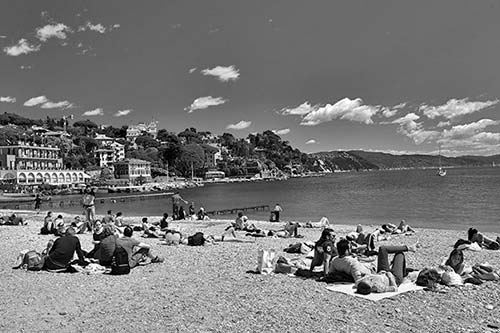
Paraggi, a small, sandy beach halfway to Portofino (and an easy stop on the bus #82 route), is better than any of the close-in Santa Margherita Ligure beaches, but it’s pricey (as much as €60/day in July and Aug)—and it can be packed with sun worshippers from Portofino (where there’s no beach—only rocks). There’s more than one bagni establishment here, so choose the one that most appeals. Off-season, the entire beach is all yours and free of charge. A narrow patch of sand smack-dab in the middle of Paraggi beach is free year-round.
One of the most beautiful and famous little Mediterranean resorts, Portofino, is just a couple miles down the coast and is so easy to visit from Santa Margherita Ligure that it can be considered a sight (details on here).
To combine the art of fishing with the beauty of the Portofino promontory from the water, arrange a trip with Luca. His boat is equipped for tonnara di Camogli: the region’s old tuna-fishing trap system (€110/2 people or €180/4 people for 4 hours, 4 people max; trip includes light snacks, snorkel masks, and stops for snorkeling and swimming; morning, afternoon, and night trips can be arranged, mobile 340-242-6483, www.portofinofishing.com, portofinofishing@gmail.com).
$$$$ Villa Anita is an elegant-yet-homey family hotel run by Daniela and her son, Sandro. They rent 12 tidy rooms—nearly all with terraces—overlooking a peaceful residential neighborhood a five-minute uphill walk from the seaside boulevard. The in-house chef offers a varying menu of Ligurian specialties nightly (dinner extra, family rooms, playground, small gym, small heated pool and sauna, loaner bikes, air-con, free parking, closed in winter, Viale Minerva 25, tel. 0185-286-543, www.hotelvillaanita.com, info@hotelvillaanita.com).
$$$$ Hotel Laurin, nestled up against castle ruins, offers 44 slick, modern, and pricey rooms looking onto the sea. All double rooms face the harbor and have terraces; on the rooftop sundeck, there’s a small pool and gym. Enrico and staff are helpful (RS%, double-paned windows, elevator, air-con, limited pay parking—request when you reserve, just past the castle at Corso Marconi 3, tel. 0185-289-971, www.laurinhotel.it, info@laurinhotel.it).
$$$ Ma Hotel is a crystal-chandelier-classy boutique hotel with a fresh, modern flair. Although it sits along a busy street, its 11 stylish and spacious rooms are at the back of the building (air-con, patio, free minibar, loaner bikes, Via XXV Aprile 18, tel. 0185-280-224, www.mahotel.it [URL inactive], info@mahotel.it, Annalisa).
$$$ Pastine Hotels is a small chain of three well-run hotels that combines solid service, sumptuous public spaces, and pleasant rooms. The two main branches are around the corner from each other, an easy walk from the station: Hotel Jolanda has lavish public spaces and regal colors, and its 50 pleasant rooms have a soothing decor (RS%, air-con, elevator, free use of small weight room, pay dry sauna, free loaner bikes, Via Luisito Costa 6, tel. 0185-287-512, www.hoteljolanda.it, info@hoteljolanda.it); Hotel Tigullio et de Milan is smaller and tidier, with updated rooms. The superior rooms are especially nice, but even most standard doubles come with a terrace—specify when you book. The rooftop sun terrace offers sunbeds, a bar, and hot tub in the summer (RS%, air-con, elevator, free loaner bikes, pay parking, Via Rainusso 3, tel. 0185-287-455, www.hoteltigullio.eu, info@hoteltigullio.eu). The newest branch, the boutique-like Hotel Sant’Andrea, has 11 rooms just above Piazza Mazzini, with a patio and whirlpool for guests (RS%, air-con, pay parking, Via Belvedere 10, tel. 0185-293-487, www.hotelsantandrea.net, info@hotelsantandrea.net).
$$ Sabini Rentals, in a dull but central residential zone, offers three straightforward rooms and one apartment with a tiny corner kitchen (RS%, family rooms, 2-night minimum, cash only, breakfast on request, laundry service, Via Belvedere 31, mobile 338-902-7582, www.sabinirentals.com, info@sabinirentals.com, Cristina and Giancarlo).
$ Albergo Annabella is an old-style budget throwback with 11 rooms—some basic but most renovated. The more expensive rooms with bathrooms and air-conditioning are overpriced, but the cheaper rooms with shared bath and fans are a solid budget option (family rooms, no breakfast, air-con, Via Costasecca 10, tel. 0185-286-531, info@albergoannabella.it, Annabella speaks just enough English).
$$$ Angolo 48, run by savvy Elisa and Valentina, serves well-presented and reasonably priced Genovese and Ligurian dishes. This cozy locale is popular: Either arrive right when they open or make a reservation. There’s great seating both on the square and inside. Try their handmade pansotti in walnut sauce (lunch Sat-Sun only 12:00-13:45, dinner Tue-Sun 18:30-22:00, closed Mon, Via Palestro 48, tel. 0185-286-650).
$$ Vineria Machiavello feels more urban Tuscan than seaside Ligurian. This well-stocked enoteca (wine shop) offers tastings and full bottles, but also serves a short menu of well-priced dishes, including beef and salmon tartare, at a few humble tables tucked between the wine racks (Wed-Mon 10:00-14:00 & 17:30-24:00, closed Tue, in the heart of the pedestrian zone at Via Cavour 17, tel. 0185-286-122).
$$ Da Pezzi, with a cheap cafeteria-style atmosphere, is packed with locals at midday and at night. They’re standing at the bar munching farinata (crêpes made from chickpeas, available Oct-May 18:00-20:00), or enjoying pesto and fresh fish in the dining room. Consider the deli counter with its Genovese picnic ingredients (Sun-Fri 10:00-14:00 & 18:15-21:00, table service after 12:00 and 18:00, closed Sat, Via Cavour 21, tel. 0185-285-303, Giancarlo and Giobatta).
All along the harbor side of Via Tommaso Bottaro, south of the marina, you’ll find restaurants, pizzerias, and bars serving food with a nautical view.
$$$ La Cambusa, perched above the fish market, is popular for its seafood. While the food is forgettable, the view from its harborside terrace is not. In cooler weather, the terrace is covered and heated. Diners receive a free glass of sciacchetrà (dessert wine) and biscotti with this book (daily 12:00-15:00 & 19:00-23:00 except closed Thu Oct-June, Via Tommaso Bottaro 1, tel. 0185-287-410, www.ristorantelacambusa.net).
At $$ Il Vernissage Lounge Bar, you can nurse your drink with a million-dollar view appreciated by tourists and locals alike. There are 20 wines by the glass, plus cocktails and spritzes, which come with a nice plate of finger food (daily 18:00-late, Sun from 11:00, Salita al Castello 8, mobile 349-220-5846, Sandro).
$$ Pizzeria il Delfino, which serves thin, big, wood-fired pizzas, offers a rustic, fun local scene, with a few quiet tables outside and tight inside seating under nautical bric-a-brac (cash only, daily 12:00-15:00 & 18:00-23:00 except closed Tue dinner, Via Cavour 29, tel. 0185-286-488).
Gelato: The best gelateria I’ve found in town—with chocolate-truffle tartufato—is Simonetti (under the castle at Piazza Martiri della Libertà 48). Gelateria Centrale, just off Piazza Veneto near the cinema, serves up pinguino (penguin), a cone with your choice of gelato dipped in chocolate (Largo Antonio Giusti 14).
Groceries: Classy Seghezzo is a well-stocked grocery, deli, and wine shop, and great for a meal to go—ask them to riscaldare (heat up) their white lasagne al pesto or dish up their special carpaccio di polpo—thinly sliced octopus (Thu-Tue 7:30-13:00 & 15:30-20:00, closed Wed, near the church on Via Cavour, tel. 0185-287-172). Cheaper and less romantic, the Carrefour Express (Largo Amendola 5) and Co-op grocery (Corso Giacomo Matteotti 9) are good places to stock up on well-priced Ligurian olive oil, pasta, and pesto (both generally open daily 8:00-21:00).
To reach the Cinque Terre towns (beyond Monterosso), you’ll usually have to change in Sestri Levante, Levanto, or Monterosso.
From Santa Margherita Ligure by Train to: Sestri Levante (2/hour, 30 minutes), Monterosso (hourly, 45 minutes), La Spezia (hourly, 1-1.5 hours), Pisa (1-2/hour, 2 hours, most with transfer, less frequent InterCity/IC goes direct), Florence (8/day, 4 hours, transfer in Pisa), Milan (about hourly, 2.5 hours, more with transfer in Genoa), Ventimiglia/French border (4/day, 4 hours; or hourly with change in Genoa), Venice (at least hourly, 6 hours with changes).
By Boat to the Cinque Terre: Tour boats make various trips to Vernazza, Porto Venere, and other ports nearly every day. Pick up a schedule of departures and excursion options from the TI, visit the ticket shack on the dock, call 0185-284-670, or check www.traghettiportofino.it.
Santa Margherita Ligure, with its aristocratic architecture, hints at old money. But nearby Portofino (por-toh-FEE-noh; pop. 500)—with its sleek jewelry shops, art galleries, and haute couture boutiques filling a humble village shell—has the sheen of new money. It’s the kind of place where the sailing masts are taller than the houses and church steeples. But the piccolo harbor, classic Italian architecture, and wooded peninsula turn glitzy Portofino into an appealing destination. Just a couple of miles down the coast, it’s a fun, easy day trip from Santa Margherita Ligure.
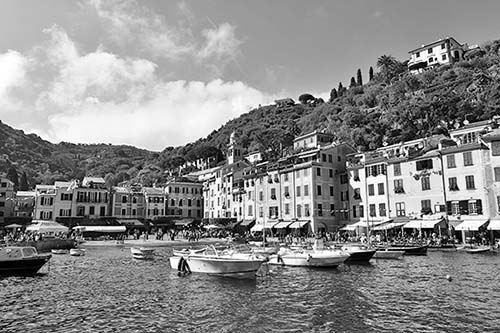
Planning Your Time: In summer, my favorite Portofino plan is to visit in the late afternoon. Leave Santa Margherita Ligure by bus at about 16:30, get off at Paraggi beach, and hike 30 minutes over the bluff into Portofino. Explore the town, splurge for a drink on the harborfront, or get a takeout fruity sundae (paciugo; pah-CHOO-goh) and sit by the water. Then return by bus to Santa Margherita Ligure for dinner (confirm late departures). If you plan to do some hiking around Portofino, come earlier in the day.
Tourist Information: The Portofino TI is tucked under an arch between the harbor and the bus stop (Wed-Mon 10:00-13:00 & 14:00-18:00, closed Tue, Via Roma 35, tel. 0185-269-024, www.comune.portofino.genova.it).
You can reach Portofino from Santa Margherita Ligure by bus or boat, or on foot. For a fun combination, you could go one way by bus and on foot from Paraggi, and the other way by boat. (I wouldn’t suggest biking it, because of the blind corners.)
By Bus: Catch bus #82 from Santa Margherita Ligure’s train station or at bus stops along the harbor (main stop in front of TI, €3 one-way or €5 round-trip, €1 more if bought from driver, 4/hour, 20 minutes, goes to Paraggi beach and then to Portofino). Buy tickets at the train station bar, the green ticket machine outside the TI, or any newsstand, tobacco shop, or shop that displays a Biglietti Bus sign. If you’re at the Piazza Veneto TI kiosk, grab a bus schedule to plan your return (last bus around 24:00 in summer).
By Boat and Bus: If you’re arriving in Portofino by boat, but will be busing back, follow the narrow lanes up from the harbor to the bus stop in Piazza della Libertà (ticket machine and tobacco store there sell tickets).
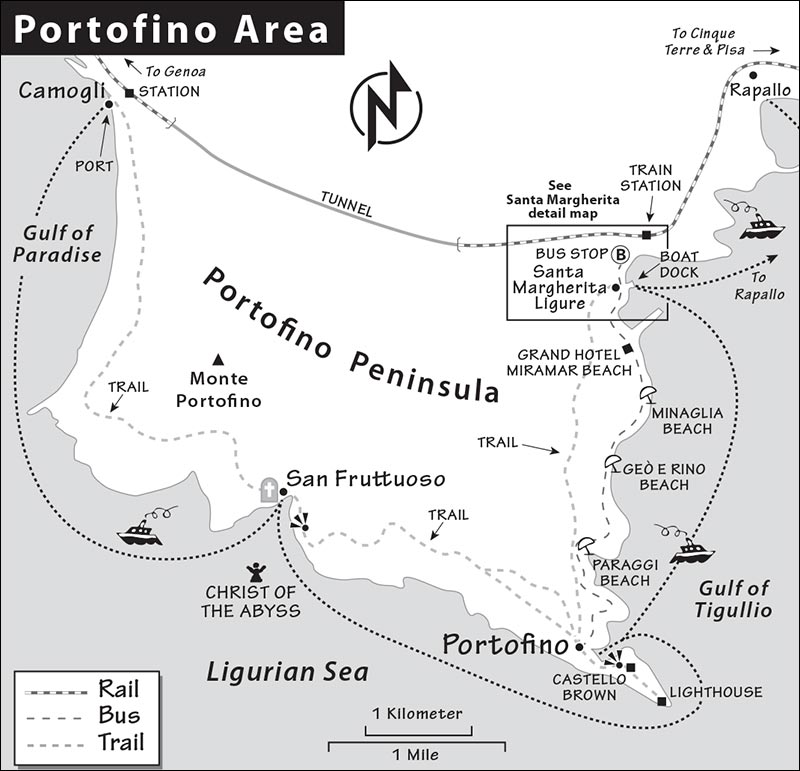
By Taxi: A taxi ride from Santa Margherita Ligure costs around €35 to Portofino or €25 to Paraggi beach (more at night). Taxi stands in Santa Margherita Ligure are at the train station and at the curb in front of the TI.)
By Boat: The boat makes the 15-minute trip with more class and scenery, and without the traffic jams. The dock in Santa Margherita Ligure juts out from the waterfront park at Piazza Martiri della Libertà, near the TI (€7 one-way, €12 round-trip; hourly departures May-Oct daily 9:15-15:15, fewer off-season; purchase tickets at the dock or onboard, tel. 0185-284-670, www.traghettiportofino.it).
On Foot: To hike from Santa Margherita Ligure to Portofino, you have two options: You can follow the sidewalk along (and sometimes hanging over) the sea (1 hour, 2.5 miles)—although traffic can be noisy, and in places, the footpath disappears. Or, if you’re hardy and ambitious, you can take a quieter two-hour hike by leaving Santa Margherita Ligure at Via Maragliano, then follow the Ligurian-symbol trail markers (keep a close eye out for red-and-white stripes). This hike takes you high into the hills. Keep left after Cappelletta delle Gave. Several blocks past a castle, you’ll drop down into Paraggi beach, where you’ll take the Portofino trail the rest of the way.
Bus-and-Hike Option: For a shorter—but rewarding—30-minute hike into Portofino, ride bus #82 from Santa Margherita Ligure only as far as Paraggi beach (tell the driver you want to get off there—you can’t miss the inlet bay with a sandy beach). At the Portofino end of the beach, look for the Parco di Portofino sign to find the steps that begin the hilly, paved trail marked Pedonale per Portofino high above the road. There’s a fair amount of up and down, but it’s all well-paved and scenic. After Paraggi, you’ll curl around another bay—with the famously top-end Hotel Splendido hovering on the hill above—before snaking your way to Portofino (you’ll pop out at a yellow-and-gray church labeled Divo Martino).
Off-season, you can easily reverse the bus-and-hike option—by hiking from Portofino to Paraggi (taking the Pedonale per Paraggi trail near the Divo Martino church), then busing from the beach to Santa Margherita Ligure—but this works only when crowds are light; on busy days, return buses fill up in Portofino and won’t stop in Paraggi.
Stand or sit on the angled boat launch where Piazza Martiri dell’Olivetta meets the harbor (or nurse an overpriced cocktail at the nearby café tables), and get oriented to Portofino. It’s one of the Mediterranean’s most beautiful and famous little resorts.
Scanning the narrow pastel houses around the harbor, notice the painted-on details—as in Santa Margherita Ligure. You may also see laundry hanging out to dry—a surprising reminder that, while Ferragamo and Prada may reside on street level, actual villagers still live upstairs.
Now look out to the well-protected natural harbor—which has held substantial strategic value ever since the Romans first founded a town here. Since then, it has been appreciated by everyone from Napoleon to the Nazis.
A new flock of fans arrived in the 1950s, when National Geographic ran a beautiful article on the idyllic port. Locals claim that’s when the Hollywood elite took note. Liz Taylor and Richard Burton came here annually (as did Liz Taylor and Eddie Fisher). During one famous party, Rex Harrison dropped his Oscar into the bay (it was recovered). Ava Gardner came down from her villa each evening for a drink—sporting her famous fur coat. Greta Garbo loved to swim naked in the harbor, not knowing (or caring) that half the town was watching. Truman Capote also called Portofino home. But VIPs were also here a century earlier. Friedrich Nietzsche famously wrote about philosophizing with the mythical prophet Zarathustra on the path between Portofino and Santa Margherita Ligure.
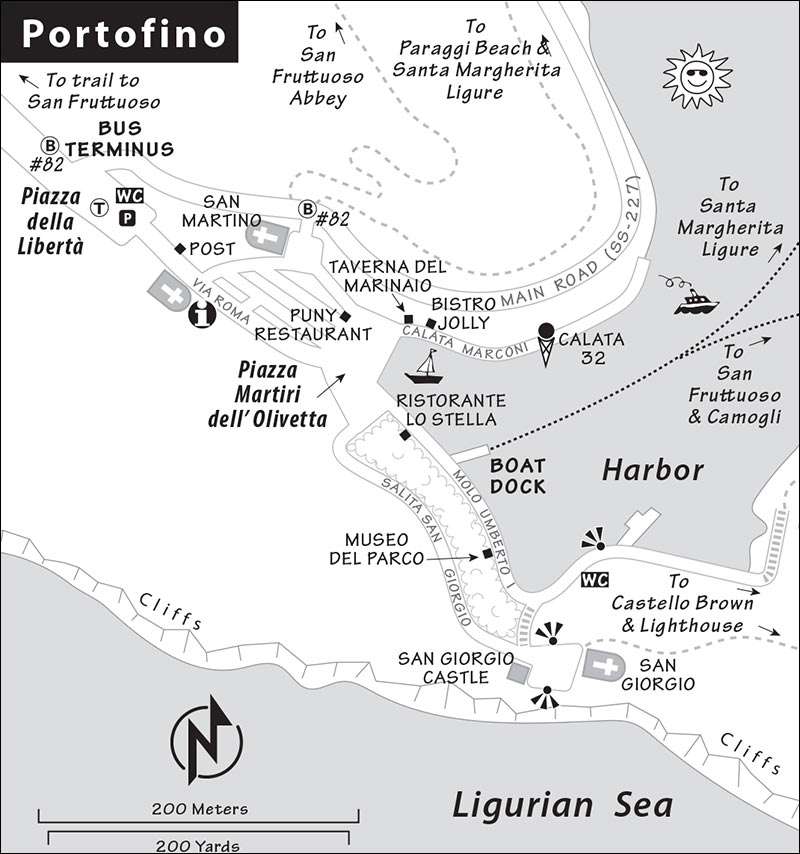
Today, the celebrity cachet lives on. When you tell locals you’re going to Portofino, they say, “Maybe you’ll see George and Amal Clooney!” Count the yachts and the tall-masted sailboats, and imagine who might be on them.
Now scan the panorama on the hillside in front of you. On the left is Castello Brown, an actual medieval castle built by the Genovese in the 16th century to protect this strategic harbor. It later became a private mansion, and today is a museum featuring lush gardens, sweeping viewpoints, and exhibits about Portofino and its history (€5, daily 10:00-18:00, June-Aug until 19:00, shorter hours off-season, tel. 0185-267-101, www.castellobrown.com).
Panning right, you’ll see the Church and Castle of San Giorgio, with its popular two-way viewpoint terrace, looking down over the port and out over the ocean. This is an easy option for a picnic with grand views. Boats back to Portofino, or on to the San Fruttuoso Abbey, depart from the harborfront below this church. The Museo del Parco (described next) is also along this embankment.
Now look back toward town. A tidy grid of narrow cobbled streets angles gently uphill to the modern part of town, around Piazza della Libertà (with bus stop and taxi stand). These streets—where budget takeaway eateries and grocery stores are mixed in with swanky shops—are a good place to hunt for picnic fare. Up on the right is the striped church of San Martino, marking the well-manicured, enjoyable 30-minute trail to Paraggi beach.
For an artsy break, walk around the harbor to the right, where you can stroll around a park littered with 148 contemporary sculptures by mostly Italian artists, including a few top names (€5, open Wed-Mon 10:00-13:30 & 15:00-20:00 in summer; closed Tue, off-season, and in bad weather).
The TIs in Portofino and Santa Margherita Ligure can outline your options. For even more detail, the Parco di Portofino can provide information on the many hiking trails that crisscross Portofino’s regional parklands (headquartered in Santa Margherita Ligure at Viale Rainusso 1, tel. 0185 289-479, www.parcoportofino.it). Here are several options easily accessible from Portofino itself.
Lighthouse Hike: A paved stone path winds up and down to the lighthouse (faro) at the scenic point beyond the Church and Castle of San Giorgio. Start your climb on little Salita San Giorgio—it’s tucked between the Delfino and Tripoli restaurants on the harborfront. Spend a few minutes enjoying the views on the church terrace (and if it’s open, duck into the cemetery with a view behind the church). Rejoin the path signed al Faro to continue up. Walls and hedges block views at some points, but in the end, you’ll be rewarded with the open sea—and a lounge/bar (open May-Sept, 25-minute walk). Consider popping into the medieval Castello Brown on the way up or down.
Paraggi Beach Hike: You can stroll the hilly pedestrian promenade through the trees from Portofino to Paraggi beach, and, if you’re lucky, see a wild boar en route (30 minutes, path starts to the right of striped Divo Martino church just above the harborfront piazza, and ends at ritzy Paraggi beach, where bus #82 stops on its way back to Santa Margherita Ligure—though in peak season, the bus may be full and won’t stop).
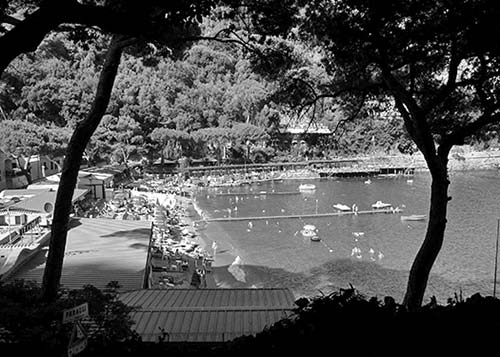
San Fruttuoso Abbey Hike: Another option is to hike out to San Fruttuoso Abbey and the nearby underwater Christ statue—see next.
This Benedictine abbey, set at the water’s edge, was established in the 10th century and is accessible only by foot or boat. On a visit here, you’ll see the monastery and its cloister, tombs of the Doria family (longtime patrons of the abbey), and a simple church. But the abbey itself isn’t the only attraction. Many are drawn here to see the statue of Christ of the Abyss (Cristo degli Abissi)—60 feet underwater, offshore from the abbey, in a specially protected marine area. The statue was placed there in 1954 for the divine protection of the region’s divers. Boats on the beach can take you out to a spot above the statue, where you can look down to just barely see the arms of Jesus-outstretched, reaching upward. Some people bring goggles and dive in for a better view (negotiate a price, usually just a few euros).
Cost and Hours: Abbey entry—€7.50; daily 10:00-17:45; shorter hours off-season and closed Mon in winter; last entry 45 minutes before closing, tel. 0185-772-703, www.abbaziadisanfruttuoso.it.
Getting There by Boat: The same boats that link Santa Margherita Ligure and Portofino continue on to the San Fruttuoso Abbey (schedule at www.traghettiportofino.it). A different company’s boats continue north from the abbey to Camogli (and its train station), Recco, and Punta Chiappa (€9 one-way, can return to Santa Margherita Ligure by train from Camogli or buy round-trip boat tickets, tel. 0185-772-091, schedule at www.golfoparadiso.it). For details inquire at the TI in Santa Margherita Ligure.
Getting There by Foot: The trail from Portofino to the abbey is steep at the beginning and end (about 2.5 hours—pick up the trailhead at the inland-most point of town, past Piazza della Libertà and the carabinieri station). You can also hike all the way there from Santa Margherita Ligure in about 4.5 hours via Portofino.
If you like planning and sticking to a timetable, you can make a one-day grand tour of the Portofino peninsula (confirm specifics of your plan, including trail details, with the TI in Santa Margherita Ligure before venturing out). Here’s the plan: Take the boat from Santa Margherita Ligure to Portofino, have a quick look at the town, and then hike 2.5 hours to San Fruttuoso. Reserve a spot in advance at the private beach called Bagni San Fruttuoso—which gives you access to showers after your hike (€15/sunbed, towel and kayak rentals, call mobile 328-450-5521 or email bagnisanfruttuoso@gmail.it to reserve, www.bagnisanfruttuoso.it). You’ll have the rest of the afternoon to enjoy the beach, visit the abbey, and see the Cristo (you’ll find seasonal restaurants on the beach). To finish your tour, take the 30-minute ferry to Camogli (last boat at 18:00 in June, 19:00 in July/Aug, you want the “blue line,” www.golfoparadiso.it) where you can catch a train for the short ride back to Santa Margherita Ligure (2/hour, 5 minutes, station is 10 minutes on foot from the ferry port).
Portofino offers all kinds of harborside dining, but the quality often doesn’t match the high prices. I’d rather dine in Santa Margherita Ligure. But if you do eat in Portofino, $$$ Ristorante lo Stella, just a few steps from the boat dock, has well-prepared dishes, friendly servers, and portholes in the bathrooms (tel. 0185-269-007). $$$ Taverna del Marinaio, across the harbor, has a prime location (soaking up the last of the day’s sun), tables under arcades, and a small, cozy, classy interior (tel. 0185-269-103); next door, $$$ Bistro Jolly offers high prices at marine-varnished tables with comfy nautical cushions. And $$$$ Puny, at the top of the harborfront square, is a famous splurge (reserve ahead, tel. 0185-269-037).
For budget options, you’ll find a variety of foccacerie, pizzerias, and grocery stores hiding out in the tiny grid of streets just up from the water. For dessert, opposite the boat dock, walk out to the little Calata 32 gelateria.
South of the Cinque Terre is the nothing-special town of La Spezia, a handy transit hub with excellent train connections. But nearby is a gem—the resort town of Porto Venere, worthy of a day trip by boat from the Cinque Terre or by bus from La Spezia.
The perfect antidote to gritty La Spezia hides just around the bay: the enchanting resort of Porto Venere (POR-toh VEH-neh-reh). Comparably scenic to the Cinque Terre towns—but with a bit of glitz—this village clings to a rocky, fortress-crowned promontory. A rainbow of tall, skinny pastel facades rises up from an inviting harborfront promenade.
Porto Venere is light on sights, but it’s a breeze to reach by boat from the Cinque Terre, and fun to explore: The higher you go, the better the views. Rather than the open sea, Porto Venere faces the beautiful Gulf of La Spezia—more romantically known as the Gulf of Poets—where Lord Byron was said to have gone for a hardy swim despite rough seas and local warnings to the contrary. (He survived...at least, for a little while longer.) Scanning the bay, you’ll see the outskirts of muscular La Spezia, the often-snow-covered peaks of the Apuan Alps, the resort town of Lerici, and—across a narrow strait—the rugged island of Palmaria.
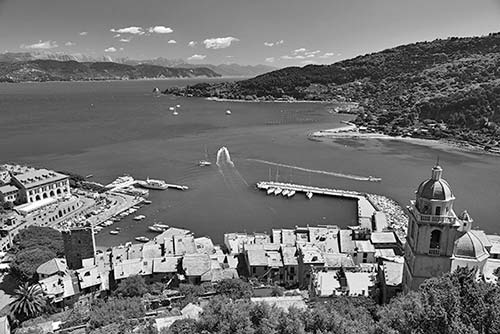
Tourist Information: The TI fills an old guard tower at the top of the main square (daily 10:00-12:00 & 15:00-19:00, closed Wed off-season, Piazza Bastreri 7, tel. 0187-790-691, www.prolocoportovenere.it).
Getting There: Porto Venere is an easy day trip from the Cinque Terre towns by boat (late April-mid-Oct, 1.5 hours from Monterosso, €23 one-way, €35 day pass includes hopping on and off, operated by 5 Terre-Golfo dei Poeti, tel. 0187-732-987, see schedule at www.navigazionegolfodeipoeti.it). You can also cruise between Porto Venere and Santa Margherita Ligure, with stops in Vernazza and Sestri Levante, using a different boat line (www.traghettiportofino.it). The scenic bus ride between La Spezia and Porto Venere curls around the Gulf of Poets (for bus details, see the end of the chapter).
For drivers, parking is challenging. In peak season, shuttle buses connect the parking lot just outside Porto Venere to the harborside square. Otherwise, test your luck with the pay spots on the seaside.
The town is essentially two streets deep: the harborfront promenade and, a block uphill, the main street (Via Capellini). A complete loop around Porto Venere includes both of these streets and a moderately steep hike up to the town’s two main churches and fortress for the views. You can see everything in just a few hours; add more time for lunch or lingering.
Along the harborfront, seafood restaurants enjoy a Technicolor backdrop, and boat captains try to talk you into a 40-minute excursion around three nearby islands. But the real town lives on Via Capellini (just through the big arch from the TI—or hike up any of the narrow stepped lanes from the harbor). Skinny and shaded, Via Capellini has a mix of restaurants, focaccia-and-pizza takeaway stands, several local shops, and boutiques selling gourmet gifty edibles and gaudy beachwear.
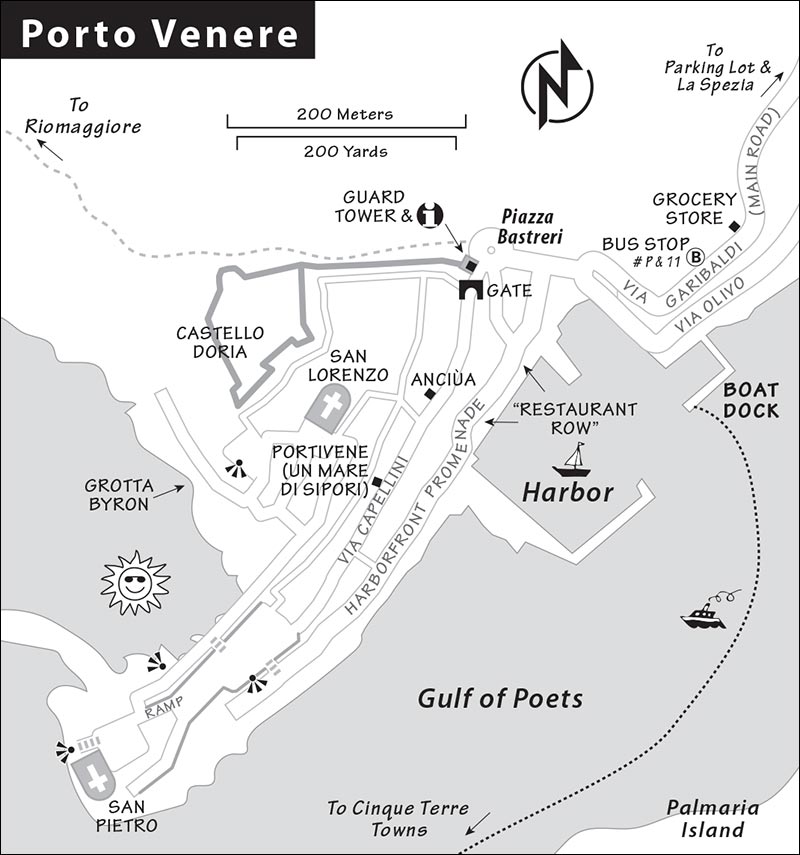
At the west end of the promenade and Via Capellini, the town comes to a point at the late-13th-century Church of San Pietro, with Gothic features and a black-and-white-striped interior typical of this region. Climb the stairs to the roof terrace for fine views in both directions (including the “Grotta Byron” sea cave).
More viewpoints line the walk from here up the stairs to the town’s other big church, San Lorenzo. With a dark and brooding Romanesque interior, this church—like much of Porto Venere—was built by the Genovese to establish a strategic foothold at the entrance to the bay in the 12th century.
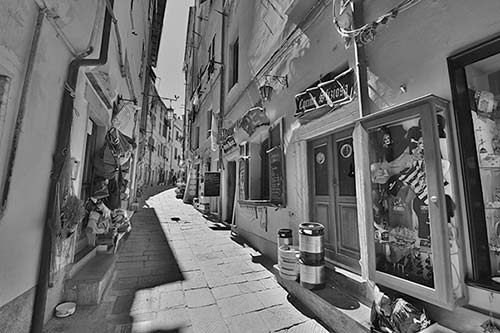
From in front of the church, more steps lead up to the town’s fortress, Castello Doria. A hulking shell, it’s not worth the money to go inside, but a hike up to the terrace out front is rewarded with striking panoramas.
From the castle, head back into town; to make this walk a loop, bear left to follow the very steeply stepped lane that runs just inside the crenellated wall back down to the TI.
Hardy hikers enjoy the five-hour (or more) hike to Riomaggiore, the nearest Cinque Terre town. Get details on this and other hikes at the TI; for more on hiking the Cinque Terre, see here.
On the harbor, next to colorful bobbing boats, take your pick of views and menus (seafood/pizza) for a meal in a memorable setting.
For better values and more variety, stroll one block inland to Via Capellini. For a sit-down meal along here, try $$ Portivene (Un Mare di Sipori), serving local dishes with modern flair at reasonable prices (reservations smart, closed Mon, at #94, tel. 0187-792-722). Better yet, browse the fun selection of takeaway shops (selling pizza slices, bruschetta, focaccia, and top-notch deli items) to put together a picnic to enjoy by the port. $ Anciùa (at #40) assembles panini to order with interesting ingredients; they also have fresh fried anchovies and other Ligurian street food.
While just a quick train ride south of the fanciful Cinque Terre (15-30 minutes), the working city of La Spezia (lah SPEH-tsee-ah; pop. 94,000) feels like “reality Italy.” Primarily a transit point connecting to the Cinque Terre, lovely Porto Venere, or to Pisa, Lucca, and other Tuscan towns, La Spezia is slim on sights and has no beaches, but has a pleasant center filled with “Liberty”-style buildings (Italian Art Nouveau). In recent years, La Spezia has become the entry point for big cruise ships that funnel groups into the Cinque Terre. While not as inviting as its neighbors, La Spezia is a functional home base if there’s no room elsewhere or if you’ve got a car.
Arrival in La Spezia: The La Spezia Centrale train station has various services lined up along track 1. In the middle of the platform you’ll find a city TI (daily 9:00-18:00, tel. 0187-026-152, www.myspezia.it) and a Cinque Terre National Park information desk, where you can buy park tickets—including the Cinque Terre Treno Card that includes both trains and trails (daily 7:30-19:30, shorter hours off-season, tel. 0187-743-500, www.parconazionale5terre.it). Don’t use the La Spezia Migliarina station, where some trains terminate, which is more remote.
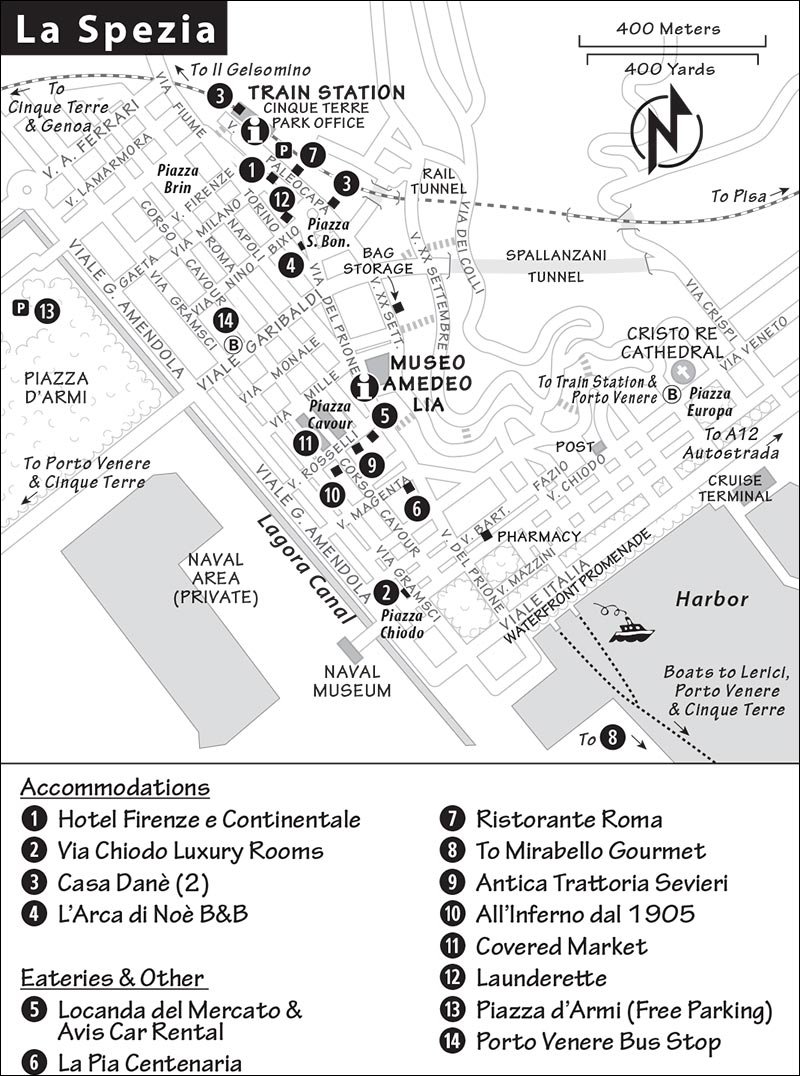
If you venture into the city, you’ll find a second TI by the Museo Amedeo Lia (daily 10:00-13:00 & 14:00-17:00, same contact info as train station TI).
For drivers who want to leave a car in La Spezia, then head to the Cinque Terre by train, the easiest parking is under the train station, at the modern Park Centro Stazione (enter from Via Fiume or Via Paleocapa, €26/day, www.mobpark.eu). Free parking is at Piazza d’Armi, a 20-minute walk or short bus ride from the station (entrance at Via XV Giugno 1918).
Baggage Storage: Day-trippers can store bags about 350 yards from the station—a three-minute walk away—at the deposito bagagli at Via XX Settembre 209 (open 24/7, self-serve lockers in 3 sizes).
Laundry: A handy self-service launderette is just below the train station (daily, Via Fiume 95).
Car Rental: You won’t need a car in the Cinque Terre region, but you may want one before or after your visit. La Spezia is the most convenient place to pick up or drop off a car near the Cinque Terre. Avis is closest to the train station (10 minutes on foot, closed Sat-Sun, Via Fratelli Rosselli 76, tel. 0187-770-270). Hertz and Europcar are located in Viale San Bartolomeo, a short taxi ride away.
If you find yourself with extra time here, and would like a meal, a museum stop, or a stroll, here’s how to accomplish all three: Exit the station, turn left, and walk a long downhill block (on Via Paleocapa Pietro) to the roundabout at Piazza Saint Bon, which marks the start of a pleasant pedestrian zone—with several eateries—on Via Fiume (which turns into Via del Prione). Continuing on this street to the harborfront gardens makes a nice stroll (it’s one mile from station to harbor). Along the way, you’ll pass the nearly deserted Museo Amedeo Lia, which displays Italian paintings from the 13th to 18th century, including minor works by Venetian masters Titian, Tintoretto, and Canaletto (€10, Tue-Sun 10:00-18:00, closed Mon, tel. 0187-731-100, http://museolia.spezianet.it).
Near La Spezia: Without a doubt, the most appealing sight is outside La Spezia: the town of Porto Venere. This gorgeous Cinque Terre-esque town, overlooking a beautiful bay, is just a 30-minute bus ride away (described earlier in this chapter).
Carrara is an easy stop for drivers connecting La Spezia and Pisa. It’s home to the world’s most famous marble quarries, where Michelangelo chose the marble for his masterpieces. Carrara’s Marble Museum (Museo Civico del Marmo) traces the story of marble-cutting here from pre-Roman times until today (closed Mon, Viale XX Settembre 85, tel. 0585-845-746). Sara Paolini is an excellent local guide (€100/half-day, will meet you at Carrara freeway exit or pick up from Carrara-Avenza train station, mobile 373-711-6695, sarapaolini@hotmail.com).
Stay in the Cinque Terre if you can, but if you’re in a bind, these accommodations are within a 10-minute walk of the station. Most include breakfast: $$$ Hotel Firenze e Continentale is your grand, Old World splurge (68 rooms, RS%, air-con, elevator, pay parking garage, Via Paleocapa 7, tel. 0187-713-200 or 0187-713-210, www.hotelfirenzecontinentale.it, info@hotelfirenzecontinentale.it).
$$ Via Chiodo Luxury Rooms, with nine elegant, bright white rooms, is a soothing retreat close to the public gardens (air-con, elevator, pay parking, Via Chiodo 13, tel. 0187-22-607, www.costaestate.it, info@costaestate.it). They also rent an apartment in Porto Venere.
For affittacamere rooms for rent, consider the stylish $$ Casa Danè, offering 10 chic rooms with comfy linens and orange trees outside the door, plus 20 more rooms inside the train station, in former train conductor barracks (some rooms overlook the tracks but good windows reduce the noise, family rooms, air-con, Via Paleocapa 4, mobile 347-351-3239, www.casadane.it, reception@casadane.it, Paolo). The homey $ L’Arca di Noè B&B has three bright, artsy, affordable rooms, all with private bath (air-con, comfy communal kitchen, Via Fiume 39, mobile 320-485-2434, montialessandra@email.it, Alessandra).
$ Il Gelsomino, best for drivers, is a homey and tranquil, three-room B&B in the hills above La Spezia overlooking the Gulf of Poets (family rooms, reconfirm arrival time in advance, Via dei Viseggi 9, tel. 0187-704-201, www.ilgelsomino.biz, ilgelsomino@inwind.it, gracious Carla and Walter Massi).
These eateries are located around the pedestrian spine of the city center, between the train station and the harbor.
$$ Locanda del Mercato offers Ligurian specialties that you can savor inside or out. For a food adventure, try the risotto with pumpkin cream or the roasted octopus (Tue-Sun 12:00-15:00 & 19:00-23:00, closed Mon, Via Fratelli Rosselli 88, tel. 0187-732-651).
$ La Pia Centenaria hosts local crowds at its counters at all hours of the day for its specialty—farinata (a chickpea pancake that can be eaten plain or with savory toppings). You can also get pizza here (Mon-Sat 10:00-22:00, closed Sun, Via Magenta 12, tel. 0187-739-999).
$$$ Ristorante Roma, next to the train station, is handy for travelers and cruisers, as they are open long hours. Their reasonable fixed-price meals even include wine, and several dishes are flavored with truffles, such as a risotto and a beef tagliata (daily 6:00-23:30, Via Pietro Paleocapa 18, tel. 0187-189-0177).
$$ Mirabello Gourmet serves light, delicious meals from a fun, informal location at the Mirabello Marina (Tue-Wed 10:00-15:00, Thu-Sun 8:00-15:00 & 18:00-23:00, closed Mon, Porto Mirabello, Viale Italia, tel. 0187-174-0168).
$$$ Antica Trattoria Sevieri is an elegant place close to the Piazza del Mercato, featuring fresh fish and superb seafood pastas and risotto. Alessandro, the chef/owner, will help you pick from the catch of the day and choose the cooking method (vegetarian and meat dishes too, Mon-Sat 12:00-15:00 & 19:00-24:00, closed Sun, Via della Canonica 13, tel. 0187-751-1776).
$ All’Inferno dal 1905 is the place if you want real local food. This small, busy restaurant with a laid-back atmosphere serves traditional chickpea soup, linguine with mussels, and homemade pesto. Look for the red door in the narrow cross-street of Piazza Cavour (Mon-Sat 12:15-14:30 & 19:30-22:30, closed Sun, tel. 0187-29458, Via L. Costa 3).
Trains leave about twice hourly for the Cinque Terre towns (direction: Levanto). A few express trains (headed to Genoa or Milano) stop only at Monterosso. Other connections from La Spezia include Pisa (about hourly, 1 hour), Florence (5/day direct, 2.5 hours, otherwise nearly hourly with change in Pisa), Rome (8/day direct, more with transfers in Pisa, 3-4 hours), Milan (about hourly, 3 hours direct or with change in Genoa), and Venice (about hourly, 5-6 hours, 1-3 changes).
It’s also possible to go by boat to the Cinque Terre, Porto Venere, and outer islands from the La Spezia dock (www.navigazionegolfodeipoeti.it).
City buses to Porto Venere generally depart from Viale Garibaldi; the bus stop is about a 10-minute walk from the train station (see the “La Spezia” map, earlier, for location; bus #P, 2/hour, 30 minutes, €3 each way; also bus #11 mid-June-mid-Sept, sporadically off-season; confirm schedule and buy tickets at TI; tickets also sold at tobacco shops, bars, and newsstands).